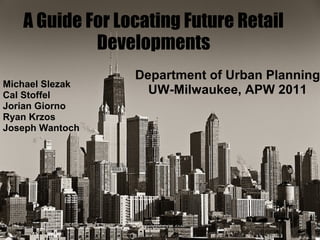
Draft_Final_Presentation
- 1. A Guide For Locating Future Retail Developments Department of Urban Planning UW-Milwaukee, APW 2011 Michael Slezak Cal Stoffel Jorian Giorno Ryan Krzos Joseph Wantoch
- 2. Problem • Industrial sector is vital to Chicago economy • Large retailers prefer industrial land • Industrial zones vulnerable to R & C intrusion • Aldermen significantly control rezoning process • Need a policy to guide retail to appropriate locations
- 3. Industrial Value • Still vital source of jobs • Significant competitive advantages • Workforce • Transportation • Research • Multiplier effect- 2.1 “Manufacturing has the greatest potential for ensuring our long-term economic growth because it represents our society’s most dynamic intersection of science, technology, research, innovations, entrepreneurial spirit and human talent” -Chicago Manufacturing Renaissance Council Cook County Employment Total Employed Average Annual Wages Retail 276,119 $29,598 Manufacturing 236,100 $68,722
- 4. Retail- Threat or Opportunity? • Larger developments will have better funding opportunities. • There will be a decreased reliance on TIF's to fund development. • Projects requiring public investment will require creative financing, i.e., third-party involvement • Deteriorating physical conditions in low-income areas will require financing from local organizations.
- 5. Big Box retail is formatting stores to capture the urban market, and Chicago will see a significant increase in this type of development. Save-A-Lot: 30 stores by 2015 Walmart: Committed to opening at least 21 stores by 2015 Specific numbers of targest Retail Trends
- 6. National Urban Retail Trends • Annual Urban Retail Spending $85 billion • $76 million/$8 million retail dollars/sq mile • Saturation of suburban markets • Developer belief in urban market cycle • Urban retail still heavily reliant on: o Low rent o Extended leasing schedules o Large parcels o Favorable project financing o Suburban format & market models • Industrial land favorable
- 7. Urban Retail Example: Northcross Mall Austin, TX
- 8. Case Studies: Ideal Retail Practices • Best practice "big box" retail is moving away from industrial tracts of large area and toward dense, well-established residential and commercial areas • Typical characteristics: o Mixed-use, multi-story First floor retail, apartments/condos above o TIF-financed parking structures Reduced parking ratios Suburban grocery ratio: 5 spaces per 1,000 sq ft Safeway Vista: 2.9 spaces per 1,000 sq ft
- 9. Case Studies: Ideal Retail Practices DC USA Washington, D.C.
- 10. Case Studies: Ideal Retail Practices Safeway Vista Washington D.C.
- 11. Case Studies: Ideal Retail Practices Whole Foods Market Alexandria, VA
- 12. Public Input- Cal • Engaged Developing Communities Project (DCP) • DCP currently is working on Visioning for Roseland Neighborhood associated with proposed Red Line Extension • Our goal was to present our recommendations for Retail Development and receive feedback, while also assisting their activities • To do so we cycled participants through focus groups including: o a Retail-based Visual Preference Survey o a Neighborhood Design Charrette o a Discussion on Safety and Crime issues o a Discussion on Transportation issues • Results from our activities affirmed our recommendations
- 13. Recommendations: Parcel Level Design The City of Chicago should consider the following design element features on the parcel level: • Aesthetics o Materials o Facade appearance o Roof design o Glazing versus blank walls • Walkability and transit connectivity o Sidewalk connections
- 14. Recommendations: Parcel Level Design H Street Wal-Mart Proposal Washington D.C. • Parking requirements and layout • Mixed-Use Developments • Size Limits/ Retail Caps o Setbacks
- 15. Recommendations: Block Level Design The City of Chicago should emphasize the use of block level design features to: • Reinforce pedestrian activity; • Improve walkability; • Improve transit; • Improve safety; • & reduce crime {Each of these areas will help address critical challenges retail developers have identified as barriers to entering underserved markets}
- 16. Recommendations: Block Level Design • Incoporate public space • Promote sense of urban enclosure • Continuous sidewalks & pedestrian connectivity • Wayfinding signage- pedestrian & transit • Use unifying elements o paving, street furniture, lighting, & trees • Orientation of transit stops {around places of interest (retail)}
- 19. Ideal Retail
- 20. Current Conditions: Retail Policy- Ryan • Zoning o Commercial and Business Districts Pedestrian Street o Planned Developments o Parking, Landscaping, Signs • Incentives o TIF o Property Tax Incentives o Enterprise Zones o Grocery-Anchored Retail Loans o City Owned Property/Negotiatied Sales
- 21. Recommendations: Policy Adjustment • Leverage Retail Development tools to incentivise development to more ideal locations. • Grocery-Anchored Retail Loan o Restrict to Food Deserts • TIFs, Property Tax incentives o Define higher priority areas • Enterprise Zone o Expand geographical area
- 23. •Incorporating residential that aims to increase purchasing power, income density, and pedestrian traffic. Safety is important to developers and consumers. Retail location analysis involves risk assessment. Prevention of loss through the design of the surrounding environment increases the attractiveness of development.
- 24. Design Scenario • Site Selection was based on Development of interest to DCP • 115th St. and Michigan Ave • Proposed Development Project including a 17,000 Sq Ft Aldi Grocery Store o ~86,000 Sq Ft of total Retail Space o 5.17 acres o Parking for 216 cars
- 27. Questions?